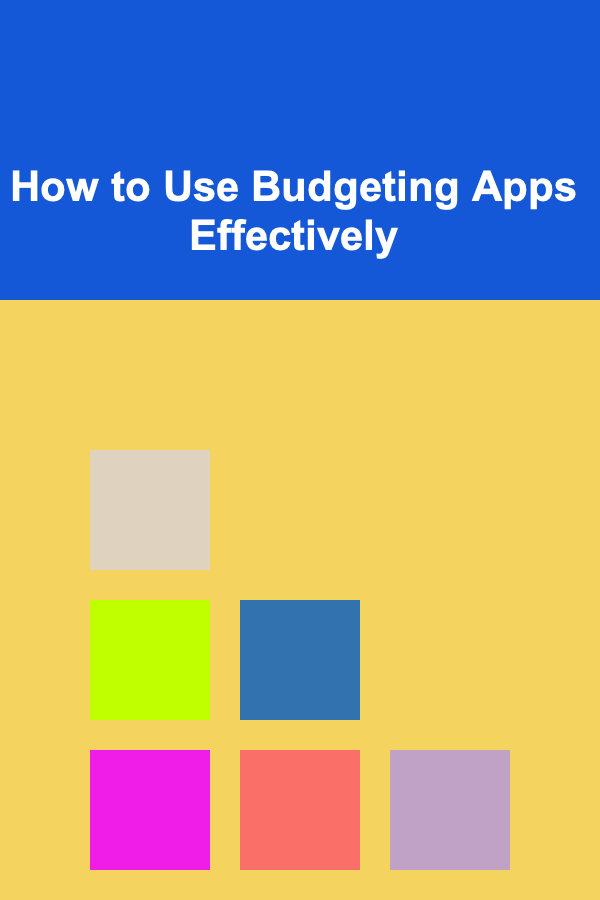
How to Use Budgeting Apps Effectively
ebook include PDF & Audio bundle (Micro Guide)
$12.99$10.99
Limited Time Offer! Order within the next:

In an era of digital solutions and mobile applications, managing personal finances has never been easier. Budgeting apps have gained immense popularity as they provide users with the tools to track spending, set financial goals, and ensure they stay on top of their budgets. However, despite their widespread use, many individuals fail to use budgeting apps to their full potential. Understanding how to effectively use these apps can significantly improve your financial health and empower you to make more informed financial decisions.
In this article, we'll explore how to use budgeting apps effectively, focusing on their core features, the best practices for getting the most out of them, and how to integrate them into your daily financial routine.
Choose the Right Budgeting App for Your Needs
The first step in using budgeting apps effectively is selecting the right one. With hundreds of budgeting apps available, it's important to consider your personal needs, financial goals, and the type of financial behavior you wish to track. Here are some key factors to consider when choosing a budgeting app:
1.1 Consider Your Financial Goals
Different apps are designed with specific financial goals in mind. Some are great for those who want to track daily spending, while others are better suited for individuals looking to save or invest. Some of the most popular apps include:
- Mint: Ideal for users who want an all-in-one solution to track spending, categorize expenses, and set financial goals.
- YNAB (You Need a Budget): Best for individuals looking to gain control over their spending by giving every dollar a job and focusing on zero-based budgeting.
- PocketGuard: A great app for individuals who want to keep track of their available spending money after accounting for bills and savings.
- GoodBudget: A simple envelope-style budgeting system that works well for users who prefer a manual approach to budgeting.
1.2 Integration with Bank Accounts and Credit Cards
To make your budgeting experience smoother, select an app that integrates easily with your bank accounts, credit cards, and other financial institutions. This allows for seamless tracking of income, expenses, and balances, reducing the need for manual data entry and ensuring accuracy.
1.3 User Interface and Ease of Use
A budgeting app's user interface (UI) is crucial. Choose one that feels intuitive and easy to navigate. An app with a confusing or overly complex design can quickly become a source of frustration, reducing your motivation to track your finances.
Setting Up Your Budget
Once you've chosen a budgeting app, the next step is setting up your budget. Setting up an effective budget is key to ensuring your financial success, and budgeting apps make this process easier than ever.
2.1 Track Your Income
Before you can create a budget, you need to know how much money you're working with. Most apps allow you to link your income sources, whether it's your salary, freelance work, or side hustles. This step ensures that you have an accurate picture of your financial situation.
2.2 Categorize Your Expenses
Expenses come in many forms, from monthly bills like rent and utilities to discretionary spending like dining out or entertainment. Most budgeting apps allow you to categorize your expenses to make tracking easier. Common categories include:
- Fixed Expenses: Rent, mortgage, insurance premiums, subscriptions, etc.
- Variable Expenses: Groceries, gas, clothing, entertainment, etc.
- Debt Payments: Student loans, credit card payments, personal loans, etc.
- Savings Goals: Emergency fund, retirement savings, vacation fund, etc.
Proper categorization helps you see where your money is going and where you may be able to cut back.
2.3 Set Realistic Spending Limits
When you set up your budget, it's important to establish realistic spending limits for each category. For instance, if your grocery budget is too low, you may end up overspending, leading to frustration and a lack of adherence to your budget. Start by reviewing past expenses, then set amounts that are realistic but also aligned with your financial goals.
2.4 Consider Creating Multiple Budgets
If your financial situation requires more complexity, you can set up multiple budgets within one app. For example, if you're saving for a vacation or planning for a large purchase, you can create a separate budget for those goals while still tracking your day-to-day expenses in a general budget.
Tracking and Managing Your Expenses
Now that you've set up your budget, it's time to actively track and manage your expenses. Budgeting apps typically have tools to help you do this automatically, but it's important to stay consistent in reviewing your financial situation to ensure that you're staying on track.
3.1 Automated Transaction Tracking
Most budgeting apps automatically sync with your bank and credit card accounts to import transactions. This saves you time on manual data entry and helps keep track of every purchase you make, ensuring that you don't forget any expense.
3.2 Review Your Spending Regularly
Even though many apps automatically categorize transactions, it's still important to regularly review your spending. Mistakes can happen, or your expenses may fall into the wrong category. By checking your transactions regularly, you can correct errors and ensure your budget is accurate.
3.3 Set Up Alerts and Notifications
Many budgeting apps allow you to set up alerts and notifications to keep you on track. For example, you can get a notification when you're close to reaching a spending limit in a particular category or when a bill is due. These reminders can help prevent overspending and ensure you stay on top of your financial goals.
Review and Adjust Your Budget
A budget is not a static document. It's important to review and adjust your budget regularly based on your changing financial situation.
4.1 Track Progress Toward Goals
Most budgeting apps allow you to set goals, such as paying off debt, saving for an emergency fund, or building up a retirement account. Regularly review your progress toward these goals and adjust your budget as needed. For example, if you receive a raise, you may want to allocate more money toward savings or debt repayment.
4.2 Make Adjustments for Life Changes
Life is unpredictable, and your budget should reflect that. If your circumstances change --- whether it's a new job, a move to a new city, or a major life event --- update your budget accordingly. Budgeting apps make it easy to adjust your income, expenses, and goals as necessary.
4.3 Evaluate and Reflect on Your Spending Habits
Review your past spending to identify patterns and trends. Do you consistently overspend in certain categories, like dining out or entertainment? This insight can help you make conscious decisions to curb unnecessary spending and allocate funds toward your financial priorities.
Leverage Additional Features
Many budgeting apps offer additional features that can enhance your financial planning.
5.1 Debt Repayment Tools
If you're working on paying off debt, some apps come with built-in debt repayment tools. These tools can help you track your progress, prioritize high-interest debts, and show you how making extra payments can reduce the total interest you pay.
5.2 Savings Tools
Certain apps include savings features that can help you automate saving for specific goals. For instance, some apps allow you to round up your purchases to the nearest dollar and save the change for a rainy day.
5.3 Investment Tracking
If you're investing in stocks, bonds, or other assets, many apps allow you to track your portfolio performance. This helps you stay informed about how your investments are doing and make any necessary adjustments to your strategy.
Best Practices for Using Budgeting Apps
To ensure that you're using your budgeting app effectively, consider the following best practices:
- Be Consistent: The more consistently you track your expenses, the more accurate your budget will be. Make it a habit to check your spending daily or weekly.
- Set Clear Financial Goals: Whether it's paying off debt or saving for a big purchase, clear goals will keep you motivated to stick to your budget.
- Don't Be Afraid to Adjust: Your budget should be flexible. If you notice you're overspending in a category, make adjustments rather than abandoning your budget altogether.
- Sync Your App Regularly: Regular synchronization ensures your financial data stays up to date and accurate, avoiding errors in your budget.
- Use the Insights Provided: Many apps offer insights into your spending habits. Use this data to make better financial decisions moving forward.
Conclusion
Budgeting apps are powerful tools that can help you take control of your finances and achieve your financial goals. By carefully choosing the right app, setting up a realistic budget, regularly tracking your expenses, and reviewing your financial situation, you can maximize the benefits of these apps. Consistency and regular adjustments are key to staying on top of your finances and making the most of the budgeting tools available to you. With the right approach, budgeting apps can transform your financial life, helping you to save more, spend wisely, and reach your goals with greater confidence.

How to Create a Festive Front Door with Simple Decorations
Read More
How to Organize a Potluck Party That's Easy and Fun
Read More
How to Use Index Funds for Low-Cost Investment Growth
Read MoreMarketing Tips for Selling Digital Reading Trackers
Read More
How to Bridge Traditional Finance with Blockchain
Read More
How to Leverage User-Generated Content Effectively
Read MoreOther Products

How to Create a Festive Front Door with Simple Decorations
Read More
How to Organize a Potluck Party That's Easy and Fun
Read More
How to Use Index Funds for Low-Cost Investment Growth
Read MoreMarketing Tips for Selling Digital Reading Trackers
Read More
How to Bridge Traditional Finance with Blockchain
Read More